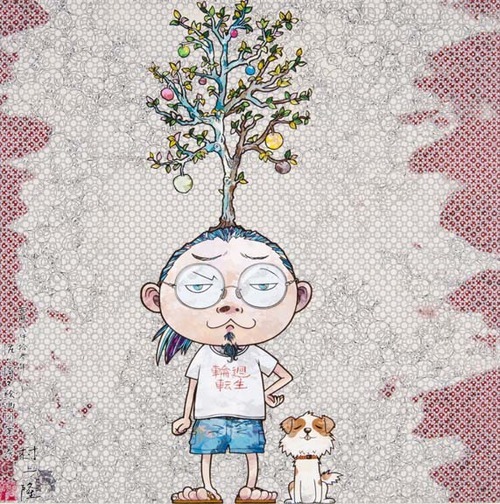
I say that confidently, for we have another of his works with which to compare it. And they nicely introduce the characteristic style of his called "superflat."

Here is an excerpted review of a 2013 show of his art in Los Angeles
In the realm of Takashi Murakami's latest artwork, the road to enlightenment—Buddhism's storied Eightfold Path—looks something like Oz, a world that's both deceptively vibrant and demonically charming. Murakami's "Arhat," now at Blum & Poe gallery in Los Angeles. presents a landscape painted in psychedelic hues and sculpted in gleaming metals. In addition to the smiling flowers and brooding skulls that have become the prolific artist's trademark imagery, decrepit monks confronting death populate "Arhat"'s terrain.
The exhibition ... is both a continuation of the artist's signature "superflat" aesthetic, which irreverently flouts distinctions between "high" and "low" art, and a marked departure from the Murakami brand. It's nearly impossible not to recognize a Murakami piece: from Louis Vuitton handbags and the cover of Kanye West's Graduation, to a collaboration with Pharrell Williams for Art Basel, Murakami's name has become synonymous with contemporary Pop.
But with "Arhat," the artist's first show in Los Angeles in five years, Murakami takes a more solemn look at mortality. The figure of the arhat—the Sanskrit term for "one who has achieved enlightenment"—has been used to depict spiritual transcendence over suffering throughout the ages.....
Gallerist Timothy Blum says Murakami's recent use of the arhat iconography continues in the Kazunobo tradition. "The incredibly detailed images of pain and chaos resonated with the people who experienced the devastation of the earthquake," Blum says. "Following the tsunami and the nuclear disaster of March 2011, Murakami felt a similar affinity toward the image and symbolism of the arhat." Last week, Murakami also debuted his first live action film, Jellyfish Eyes, which presents the narrative of young boy's life in post-Fukushima Japan.
Echoing the Buddhist statuary found in the artist's native Japan, the monumental sculptures included in Arhat are among the show's most striking pieces. Flame of Desire—Gold, 2013 depicts a massive, mirrored skill enveloped in flames—an invitation for the viewer to confront mortality on a large scale.
Takashi Murakami in his blend of high and low culture reminds one of Jeff Koons, except of course Murakami is original and intelligent.
No comments:
Post a Comment